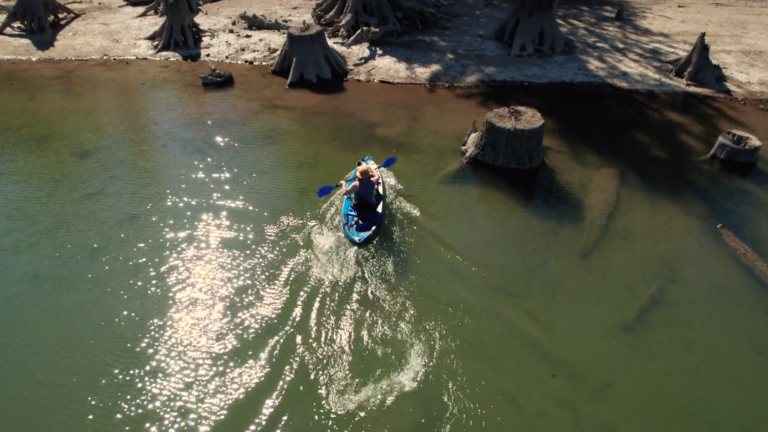Choosing the right fishing reel for your next fishing adventure is a big deal. Using the correct equipment can make your experience either super successful or an unfortunate failure. Since no one likes catching no fish and coming home empty-handed, we’re here to help you make the right decision.
With our help, you’ll be able to choose the perfect fishing reel for your needs in the blink of an eye! But first, you should get informed about the types of fishing reels that exist so that you can pick the one that works for you like a true pro.
If you’re a beginner and you’re still not quite sure what any of this means, don’t be discouraged. Completing this task may sound difficult, but you can use our summarized guides and info to learn all there is to know about fishing reels and picking the ideal one hassle-free! All you need to do is follow our article, and you’ll be ready for your fishing journey in a jiffy! Let’s hop right into it.
Table of Contents
ToggleWhat Is a Fishing Reel?

To be able to choose the right fishing reel for your needs, you should first get acquainted with what a fishing reel is exactly. You may already know this if you have experience in fishing, but if you are a beginner, you should pay attention to every detail. That is the best way to make the best decision and end up happy with the results.
A fishing reel is a part of your fishing rod. It is a device that is attached to it, and it is used to deploy and retrieve the fishing line. There is typically a spool that is attached to the axle that you use for this purpose. With that being said, you understand that a fishing reel is one of the key components of your fishing rod, as well as how important having the right one is.
Two of the most common types of fishing reels include an open face fishing reel and a closed face fishing reel. If you want to pick the right one for your next fishing journey, take a look at the guides below to find more detail about each of these two fishing reel types.
A Guide to Understanding Open Face Fishing Reels

We’ll begin with the open face fishing reel, which is also known as a spinning reel. Now, this fishing reel is one of the most commonly used ones. The majority of the moving parts on this rod, as well as the spool, are open, as the name suggests. What this means is that they are not located behind the spool’s cover. What’s characteristic of this reel is that it is usually mounted below the rod. The handle can normally be locked, which will further keep the fishing line from spinning backward or coming off. There is also a wire bail included so that you can perform distance casting.
Another thing that is important to note when it comes to open face fishing reels is that beginners typically don’t go for this type. There is no rule that says that amateurs cannot use it, but it is normally used by more advanced and experienced users.
The reason behind this is that using open face fishing reels typically requires some practice since you will need to use your finger to guide the line. Doing this successfully requires some time and practice, so that is why beginners tend to steer clear of using this one right away.
A Guide to Understanding Closed Face Fishing Reels

We’ll move on to the closed face fishing reels which are a bit more easy to use than the open face ones. Closed face fishing reels don’t have exposed lines. The fishing line is nicely enclosed inside the nose cone. There is a small hole that lets the line pass through, and the reel isn’t mounted below but above the handle. These reels are much easier to use and cast. All you need to do is find the button that releases the line and press it.
You don’t need to practice using your finger to follow the fishing line with this reel. One of the most common and straightforward closed face fishing reels is the spincast reel. Once you learn how to align the timing of releasing the line and snapping the rod, you’ll be able to use your closed face fishing reel like a real pro.
Open Vs. Closed Face Fishing Reels—Key Differences
Since you now understand how both the open and closed face fishing reels work, we’re going to walk you through some of their key differences. We already mentioned a couple of them, but there is more to come. So sit back, relax, and take a look at the list below to find out what the main differences between open and closed face fishing reels are:
1. Casting
The first difference we’re going to mention is in the casting. Closed face fishing reels are way more accessible, and anyone can use them to cast successfully. There is not much practice required to use this one since it does most work for you. All you need to do is push the button and cast it.
As for the open face one, it’s a different story. A little more finesse is required when using this fishing reel, so it’s not recommended and easy to use if you’re a beginner. Experienced users say it gets easier with time and practice, and even prefer to cast using this reel. However, if you’re still not there, you should go with the closed face one for ease of casting.
2. Accuracy
The next difference we’re going over is accuracy. Although we already mentioned that using an open face fishing reel is a tad more difficult, there are instances when using this one is preferred. This one provides you with a higher level of accuracy than the closed face one, but only when you learn how to use it perfectly.
It goes without saying that this isn’t a given and that you can’t simply pick up your rod and start casting. But spending a little bit of time practicing using the open face reel will sure go a long way when it comes to fishing with excellent accuracy later on.
3. Casting Distance

Let’s continue with the casting distance, which is one of the most important factors to consider when fishing. The ability to cast longer distances is very important if you want to catch bigger fish, so having the right reel to do so is essential.
Now, this is yet another instance where an open face fishing reel would take the win. The way these reels are designed will allow you to store more fishing lines on your spool, which is one of the main factors that allow you to cast over bigger distances.
4. Versatility
When it comes to versatility, you’ll want a rod and reel that is able to work in a variety of conditions. Another thing you’ll want is to pull and catch bigger fish hassle-free. Unfortunately, that is not something that you’d be able to do with ease if you use a closed face fishing reel.
These aren’t made to be used in seawater, for example, so you won’t be able to use them in any condition. They are also not designed to have a lot of hauling power and catch bigger and heavier fish. That is why an open face fishing reel would be the winner when it comes to versatility as well.
5. Quality
Lastly, let’s talk about quality. Having a fishing rod and reel that are high in quality and made to last is very important. It’s true that quality depends on a variety of factors, including the brand in question, and more. However, open face fishing reels tend to be higher in quality for some reason.
They are made to withstand various conditions and to last for a long time, unlike the closed face ones. This is also typically reflected in the price as well, so you should note that getting an open face fishing reel would probably cost a little more than buying a closed face one would.
Conclusion
It’s no secret that picking the right fishing reel can often seem like a daunting task, especially if it’s your first time doing it. The good news is that it doesn’t have to be that difficult! Once you get properly informed and gather the info we provided in our guides, you’ll be able to pick your ideal fishing reel with ease!
And the best part is that it won’t take more than 10 minutes! You can forget about wasting time and doing things the hard way. With our help, you’ll be ready for your next fishing adventure in record time and with minimum effort.
Adelaide Gentry, a seasoned kayaking enthusiast and expert, is the driving force behind KayakPaddling.net. With over a decade of experience navigating the world’s most challenging waterways, Adelaide combines her passion for adventure with a deep knowledge of kayaking to provide insightful and practical guidance for paddlers of all levels.
Related Posts:
- 16 Best Kayak For Beginners 2024 - Kayaking Adventure Gear
- 14 Best Fishing Line for Baitcaster 2024 - For…
- 13 Best Fishing Kayak Under $500 in 2024 -…
- 12 Best Rod For Daiwa BG 5000: - The Right Combo For Reel
- 10 Best Fish Finders Under $200 2024 - Top Affordable Picks
- 10 Best Fishing Reel for Salmon 2024 - Reels for Big Gamers












